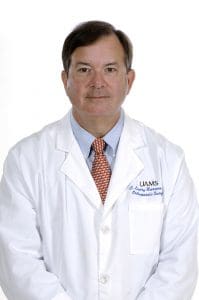View Larger Image

Arlene Margolis converses with Goree during a visit to clinic.
In Severe Pain for 8 Years, Retired Teacher Finds Relief at UAMS
| Complex regional pain syndrome is rare, affecting only one in 300,000 people. Yet it is the most painful chronic disease known to humankind, according to the McGill pain index. And some patients live with this disease for years and even decades before ever receiving a diagnosis.
Johnathan Goree, M.D., director of the chronic pain division at UAMS and assistant professor in the College of Medicine’s Department of Anesthesiology, says the medical community still has a lot to learn about the disease.
“What we do know is there is an overgrowth of nerves that changes the way a patient senses and feels pain,” Goree said. “It develops primarily in a patient’s arms or legs, usually after a surgery, fracture or immobility.”
Arlene Margolis, 70, of Little Rock, had lived with chronic pain surrounding her left knee for eight years.
It began after a knee replacement surgery. When the pain did not subside as expected, Margolis’ surgeon recommended she have another surgery to fix what was causing her pain. She would eventually have three surgeries on the same knee, with no relief. Her knee was swollen, painful and felt warmer than the rest of her body. Margolis tried multiple approaches to ease her pain over the years including visiting a chiropractor, an acupuncturist and a massage therapist.
“The pain just becomes part of your life,” Margolis said. “Every day I would try to get as much accomplished as I could before it became unbearable. You become aware of the types of chairs you sit in. Does the chair have arms? Is there a table nearby that I can hold on to when I try to get up?”
Margolis says because she tosses in her sleep there was pain from the moment she woke up, and it worsened as the day progressed.
“I didn’t realize how much movement my legs would do while I was asleep.”
Before she was in constant pain, Margolis was active. She walked for more than an hour a day for exercise and participated in water aerobics. She was constantly on her feet as an elementary school teacher, a career she enjoyed for 35 years. After her surgeries, she stopped exercising, retired from teaching and gave up attending regular worship services.
“I couldn’t get up and down out of a chair at the synagogue,” she said. “So I stopped going.”
Then Margolis came to UAMS.
She met with C. Lowry Barnes, M.D., chair of the UAMS Department of Orthopaedic Surgery.
“Dr. Barnes thought it would be too risky to do another surgery,” Margolis said. “He referred me to Dr. Goree. The initial treatment plan was not completely successful so Dr. Goree reassessed and interviewed me before diagnosing me with CRPS. He was the first doctor who ever told me about that (disease).”
Her treatment included a series of injections over a six-week period. The injections numbed the pain and gave her brain a chance to stop sending pain messages to her knee. When she came to her appointment for the last set of injections, she had no pain in her knee. It was no longer swollen or hot.
Goree said unfortunately many patients go undiagnosed because so few physicians are familiar with the disease. But through research and collaboration, UAMS is providing hope for these patients.
“We created a protocol here with the orthopaedic surgeons and the physical therapists to help us identify and treat patients with this disease,” Goree said. “We know physical therapy is vital to treatment, but the challenge is that the patients are in too much pain to participate in the physical therapy they need. With a combination of nerve pain medications and injection to block the overly excited nerves, we can often get patients to a place where they can tolerate physical therapy and work toward a cure.”
For patients who have severe cases of CRPS, Goree says neuromodulation is another option. Neuromodulation alters the nerve signals of diseased nerves through delivery of an electricity. Some examples of neuromodulation treatment offered at UAMS include spinal cord stimulation and dorsal root ganglion stimulation. The dorsal root ganglion is a cluster of neurons near the spinal cord that may contain most of the diseased nerve signals that cause CRPS.
“In this procedure, we place the device directly on the dorsal root ganglion, the nerves that cause the disease. It works like a pacemaker for the nerves and alters the diseased pain signals, allowing patients to go through the therapy they need. For some patients, this new technology has been a game changer.”
For Goree, stories like Margolis’ are rewarding. He was excited when she told him she could walk, dress and put on shoes with no pain. Now she is working on regaining strength after so many years of not being able to use her leg.
“As I continue to treat this disease, I learn more about the pain and challenges patients face every day. I’m motivated to make sure that I provide patients with the best chance at getting their life back. Whenever someone tells me they have been successful, I get emotional because it validates the work I do,” Goree said.

